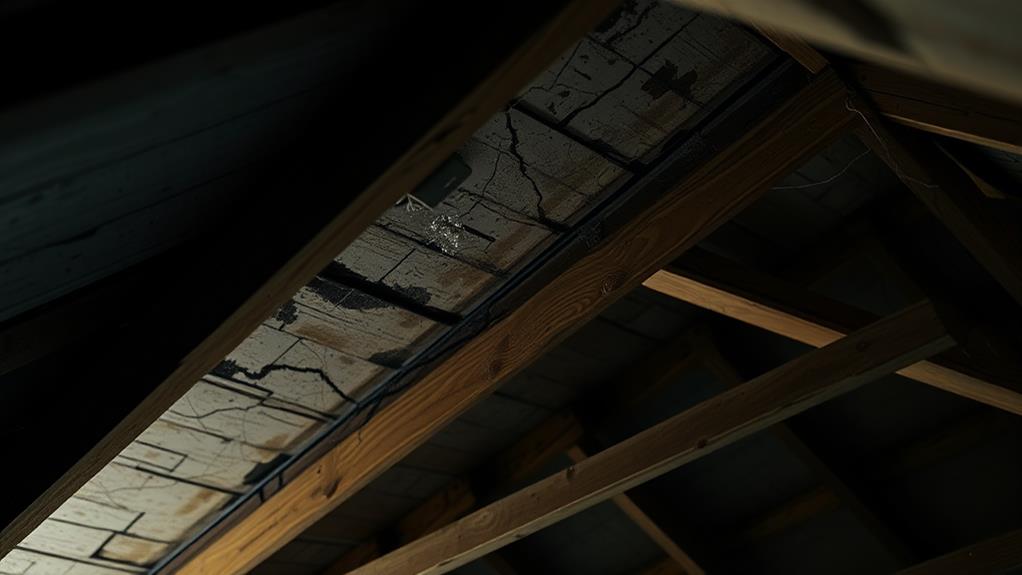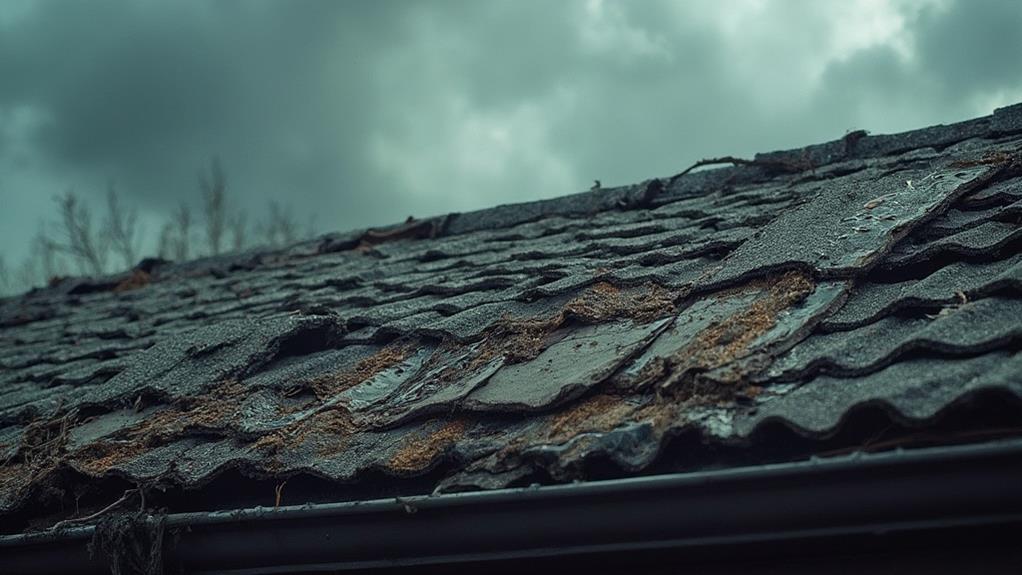Ignoring minor roof damage after a storm can lead to severe consequences. What appears minimal may mask underlying structural weaknesses, allowing water infiltration and mold growth. Small issues can escalate into major repairs, compromising energy efficiency and shortening the roof's lifespan. Insurance claims may be complicated or denied due to neglect. Hidden damage can spread to interior spaces, causing extensive harm. Prompt attention to minor roof problems is crucial for maintaining your home's integrity, safety, and value. Understanding the full scope of potential risks empowers homeowners to take proactive measures and protect their investment.
Hidden Structural Weaknesses

Hidden structural weaknesses can develop insidiously after a storm, even when roof damage appears minimal. What may seem like a small issue on the surface can mask more serious underlying problems. Storms can loosen shingles, create micro-cracks in roofing materials, or compromise the integrity of flashing and sealants.
These subtle damages can allow moisture to penetrate the roof's protective layers, leading to gradual deterioration of the supporting structure. Over time, this undetected water intrusion can weaken roof decking, damage insulation, and even compromise the building's framework. Wooden support beams may rot, metal fasteners can corrode, and mold growth can occur in hidden spaces.
The cumulative effect of these hidden structural weaknesses can significantly reduce the roof's load-bearing capacity and overall lifespan. Moreover, these concealed issues often worsen exponentially, as each subsequent weather event exacerbates the existing damage. By the time visible signs of structural weakness become apparent, such as sagging ceilings or water stains, the damage may have progressed to a point requiring extensive and costly repairs.
Regular professional inspections following storms are crucial to identify and address these hidden structural weaknesses before they escalate into major problems.
Water Damage and Mold Growth
The insidious nature of water damage and mold growth cannot be overstated when discussing the consequences of neglecting minor roof damage. Even small leaks or compromised areas in a roof can allow moisture to penetrate the structure, leading to a cascade of problems that worsen over time.
Water infiltration can cause rotting of wooden support structures, weakening the overall integrity of the roof and potentially the entire building. As moisture seeps into insulation, its effectiveness diminishes, resulting in increased energy costs.
Drywall and ceiling materials may become stained, warped, or crumble, necessitating expensive repairs. Perhaps most concerning is the potential for mold growth. Mold thrives in damp, dark environments, and can spread rapidly through a home's interior. This not only causes further structural damage but also poses significant health risks to occupants.
Mold spores can trigger allergic reactions, respiratory issues, and other health problems, particularly in vulnerable individuals such as children, the elderly, or those with compromised immune systems. Addressing minor roof damage promptly is crucial to preventing these escalating issues, safeguarding both the structural integrity of the building and the health of its inhabitants.
Escalating Repair Costs

Delaying repairs on minor roof damage can lead to exponentially increasing costs over time. What begins as a small leak or a few missing shingles can quickly escalate into a major structural issue if left unaddressed.
As water continues to penetrate the roof, it damages underlying materials, weakens support structures, and compromises the integrity of the entire roofing system.
The longer these issues persist, the more extensive and expensive the repairs become. A simple shingle replacement might cost a few hundred dollars, but if neglected, it could lead to thousands in repairs for water damage, mold remediation, and structural repairs. In severe cases, complete roof replacement may be necessary, costing tens of thousands of dollars.
Additionally, insurance companies may deny claims for damage that resulted from neglect or lack of maintenance. This leaves homeowners fully responsible for the repair costs. Regular inspections and prompt repairs can prevent these escalating expenses. By addressing minor issues immediately, homeowners can avoid the financial burden of major repairs and protect their investment in the long term.
Energy Efficiency Reduction
Beyond the visible damage, minor roof issues can significantly impact a home's energy efficiency. Small leaks or compromised insulation can lead to increased heat transfer, forcing HVAC systems to work harder to maintain desired temperatures. This overcompensation results in higher energy consumption and inflated utility bills.
Damaged shingles or tiles may allow for air infiltration, creating drafts and inconsistent indoor temperatures. These drafts not only affect comfort but also strain heating and cooling systems. Additionally, moisture intrusion through minor roof damage can degrade insulation effectiveness over time, further reducing the home's thermal barrier.
Even slight misalignments in roofing materials can create gaps that compromise the roof's ability to reflect solar heat, leading to increased heat absorption during summer months. This heat gain translates to higher cooling costs and potential discomfort for occupants.
Addressing minor roof damage promptly is crucial for maintaining optimal energy efficiency. Regular inspections and timely repairs can prevent these issues from escalating, ensuring the roof continues to function as an effective barrier against the elements while supporting the home's overall energy performance.
Insurance Claim Complications

When homeowners neglect minor roof damage, they may unknowingly jeopardize their insurance coverage. Insurance policies typically require policyholders to mitigate further damage after a storm, which includes addressing minor roof issues promptly. Failure to do so can lead to claim denials or reduced payouts if the damage worsens over time.
Insurance companies may argue that the homeowner's negligence contributed to the extent of the damage, potentially voiding coverage for repairs. Additionally, if too much time passes between the initial incident and the claim filing, insurers might question the cause of the damage, making it difficult to prove storm-related origins.
Documenting minor roof damage immediately after a storm is crucial. Homeowners should take photos, keep repair estimates, and maintain a record of all communication with their insurance company. This documentation can help support future claims and demonstrate proactive maintenance efforts.
Some policies have specific time limits for reporting damage, and delays may result in claim rejection. Regular roof inspections and timely repairs not only preserve insurance coverage but also demonstrate responsible homeownership, potentially leading to more favorable claim outcomes and maintained policy rates in the long term.
Shortened Roof Lifespan
Minor roof damage, if left unaddressed, can significantly reduce a roof's expected lifespan. Even small issues like missing shingles, minor leaks, or slight structural damage can escalate rapidly, compromising the roof's integrity over time. These seemingly insignificant problems often allow moisture to penetrate the roof's layers, leading to wood rot, mold growth, and weakened structural components.
The cumulative effect of neglected minor damage accelerates the aging process of roofing materials. For instance, exposed underlayment due to missing shingles can quickly deteriorate when subjected to UV rays and weather elements. This deterioration spreads, affecting surrounding areas and potentially requiring extensive repairs or premature replacement.
Additionally, small leaks can cause insulation to become waterlogged, reducing its effectiveness and putting extra strain on the roof's structure. Over time, this added weight and compromised insulation can lead to sagging and further damage. By ignoring these issues, homeowners may find themselves facing a full roof replacement years earlier than the manufacturer's projected lifespan, incurring significant unexpected costs and potentially compromising their home's overall structural integrity.
Interior Damage Risks

The risks associated with minor roof damage extend far beyond the roof itself, posing significant threats to a home's interior. Even small leaks or compromised areas can allow water to infiltrate the structure, leading to a cascade of potential problems.
Moisture intrusion can damage ceilings, walls, and flooring, causing unsightly stains, peeling paint, and warped surfaces. Over time, this can compromise the integrity of these structural elements.
More insidiously, persistent moisture creates an ideal environment for mold and mildew growth. These fungi not only cause further damage to building materials but also pose serious health risks to occupants, particularly those with respiratory issues or allergies. Additionally, water seepage can affect electrical systems, potentially leading to short circuits, equipment failure, or fire hazards.
Insulation is another vulnerable component. When wet, it loses its effectiveness, leading to increased energy costs and potential ice dam formation in colder climates. Furthermore, moisture can weaken wooden support structures, compromising the overall stability of the home. By addressing minor roof damage promptly, homeowners can prevent these interior issues, safeguarding both their property's value and their family's well-being.
Property Value Depreciation
Homeowners often underestimate the impact of minor roof damage on their property's overall value. Neglecting seemingly insignificant roof issues can lead to substantial depreciation over time. Potential buyers and real estate appraisers are increasingly vigilant about roof conditions, recognizing them as indicators of overall home maintenance.
Even small signs of damage, such as missing shingles or minor leaks, can raise red flags during property inspections. These issues suggest the possibility of more extensive, hidden problems, causing buyers to hesitate or lower their offers. Additionally, visible roof damage can negatively affect a home's curb appeal, diminishing its perceived value in the real estate market.
Insurance companies also consider roof condition when determining coverage and premiums. A damaged roof may lead to higher insurance costs or reduced coverage, further impacting the property's overall value proposition. Moreover, in competitive real estate markets, homes with pristine roofs often command higher prices and sell faster than those with visible damage.
To maintain and potentially increase property value, homeowners should promptly address any roof damage, regardless of its apparent severity. Regular inspections and timely repairs can prevent minor issues from escalating into major problems that significantly depreciate the home's worth.
Frequently Asked Questions
How Can I Safely Inspect My Roof After a Storm?
To safely inspect your roof after a storm, use binoculars for a ground-level assessment. Look for missing shingles, debris, or visible damage. For a closer inspection, hire a professional roofer with proper safety equipment and expertise.
What Types of Storms Are Most Likely to Cause Roof Damage?
Catastrophic hurricanes and apocalyptic tornadoes are the undisputed champions of roof destruction! But in reality, any storm packing high winds, hail, or heavy rain can potentially damage roofs. Severe thunderstorms, blizzards, and even intense heat waves pose risks to roof integrity.
Are There DIY Temporary Fixes for Minor Roof Damage?
While there are temporary DIY fixes for minor roof damage, such as applying roofing tar or using a tarp, it's crucial to address issues promptly and professionally. These short-term solutions can prevent further damage until proper repairs are made.
How Often Should I Have My Roof Professionally Inspected?
Professional roof inspections are recommended annually, especially in areas prone to severe weather. However, for older roofs or those in harsh climates, biannual inspections may be necessary. Additionally, schedule an inspection after any significant storm or weather event.
What Roof Materials Are Most Resistant to Storm Damage?
Metal roofing, slate, and concrete tiles are highly resistant to storm damage. These materials offer superior durability against wind, hail, and heavy rain. Synthetic slate and impact-resistant asphalt shingles also provide enhanced storm protection for residential roofs.
Conclusion
Neglecting minor roof damage post-storm leads to severe consequences. Hidden weaknesses grow, water infiltrates, and mold spreads. Repair costs escalate, energy efficiency plummets, and insurance claims complicate. Roof lifespan shortens, interior damage threatens, and property values decline. Prompt attention to seemingly insignificant issues prevents these cascading problems, preserves structural integrity, and maintains home value. Vigilance in roof maintenance safeguards against long-term financial burdens, ensures occupant safety, and protects the overall investment in the property.

